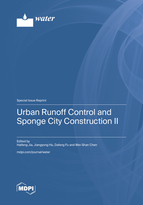Urban Runoff Control and Sponge City Construction II
A special issue of Water (ISSN 2073-4441). This special issue belongs to the section "Urban Water Management".
Deadline for manuscript submissions: closed (31 August 2023) | Viewed by 20196
Special Issue Editors
Interests: environmental planning and management; environmental system analysis; water quality and the hydrology model
Special Issues, Collections and Topics in MDPI journals
Interests: advanced oxidation process; emerging contaminant detection and removal; water disinfection technology; biofilm control; stormwater management; water treatment and reuse; water quality assessment
Special Issues, Collections and Topics in MDPI journals
Interests: sponge city; urban hydrology; water resource management; water environment and aquatic ecosystem restoration
Special Issues, Collections and Topics in MDPI journals
Interests: nature-based solutions; blue-green infrastructure; urban infrastructure transition; adaptation/transition pathway analysis; rainwater harvest; water reuse; life cycle assessment
Special Issue Information
Dear Colleagues,
We are seeking papers for the Special Issue “Urban Runoff Control and Sponge City Construction II”.
Rapid urbanization, which sometimes lacks adequate planning and design, has led to worsening city syndrome situations, such as urban flooding, water pollution, heat-island effects, and ecologic deterioration. Sponge city construction—which integrates green and gray infrastructure—principles have become the new paradigm for a sustainable urban stormwater management strategy.
Deviating from the traditional rapid-draining approach, the new paradigm calls for the use of natural systems, such as soil and vegetation, as part of the urban runoff control strategy. It has become a widespread focus in urban water management research and practices globally. In this context, in order to present the latest developments, technologies, and case studies related to urban runoff control and sponge city construction, following the success of “Urban Runoff Control and Sponge City Construction I”,we would like to propose this Special Issue.
All manuscripts related to the proposed topic are welcome. Topics of interest include but are not limited to the following: theories and technologies of sponge city construction; urban hydrology; methods of quantifying the benefits of a sponge city; rainwater utilization; practices that mitigate urban flooding and soil erosion; the performance of GI; the impact of media; preferential flow paths; vegetation; climate; design of the hydrological, hydrodynamic and pollutant removal processes; and case studies on sustainable urban design and management using LID-GI principles and practices. Contributions to this Special Issue could include GI laboratory and field tests, innovative doped-media, or design and modelling approaches for simulating event-based or long-term performance.
Original research papers or critical reviews are encouraged.
Prof. Dr. Haifeng Jia
Prof. Dr. Jiangyong Hu
Prof. Dr. Dafang Fu
Dr. Wei-Shan Chen
Guest Editors
Manuscript Submission Information
Manuscripts should be submitted online at www.mdpi.com by registering and logging in to this website. Once you are registered, click here to go to the submission form. Manuscripts can be submitted until the deadline. All submissions that pass pre-check are peer-reviewed. Accepted papers will be published continuously in the journal (as soon as accepted) and will be listed together on the special issue website. Research articles, review articles as well as short communications are invited. For planned papers, a title and short abstract (about 100 words) can be sent to the Editorial Office for announcement on this website.
Submitted manuscripts should not have been published previously, nor be under consideration for publication elsewhere (except conference proceedings papers). All manuscripts are thoroughly refereed through a single-blind peer-review process. A guide for authors and other relevant information for submission of manuscripts is available on the Instructions for Authors page. Water is an international peer-reviewed open access semimonthly journal published by MDPI.
Please visit the Instructions for Authors page before submitting a manuscript. The Article Processing Charge (APC) for publication in this open access journal is 2600 CHF (Swiss Francs). Submitted papers should be well formatted and use good English. Authors may use MDPI's English editing service prior to publication or during author revisions.
Keywords
- Urban runoff
- Sponge city
- Nature-based solutions
- LID
- SUDS
- Monitoring and evaluation
- Modelling
- Planning and management
- Urban flooding
- Urban river rehabilitation









